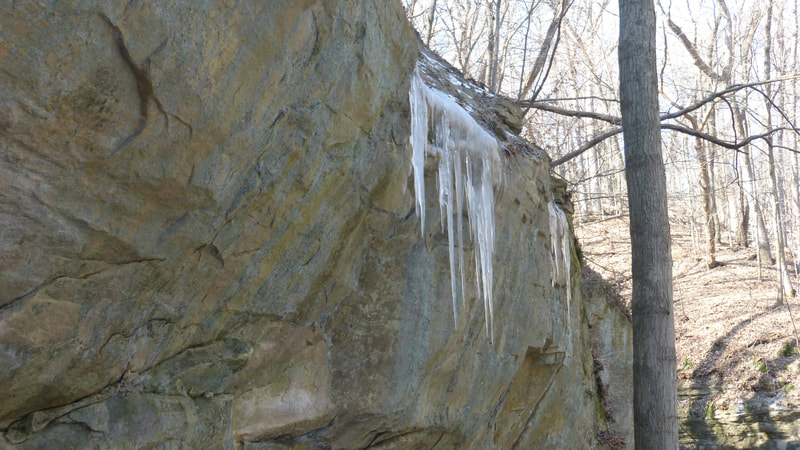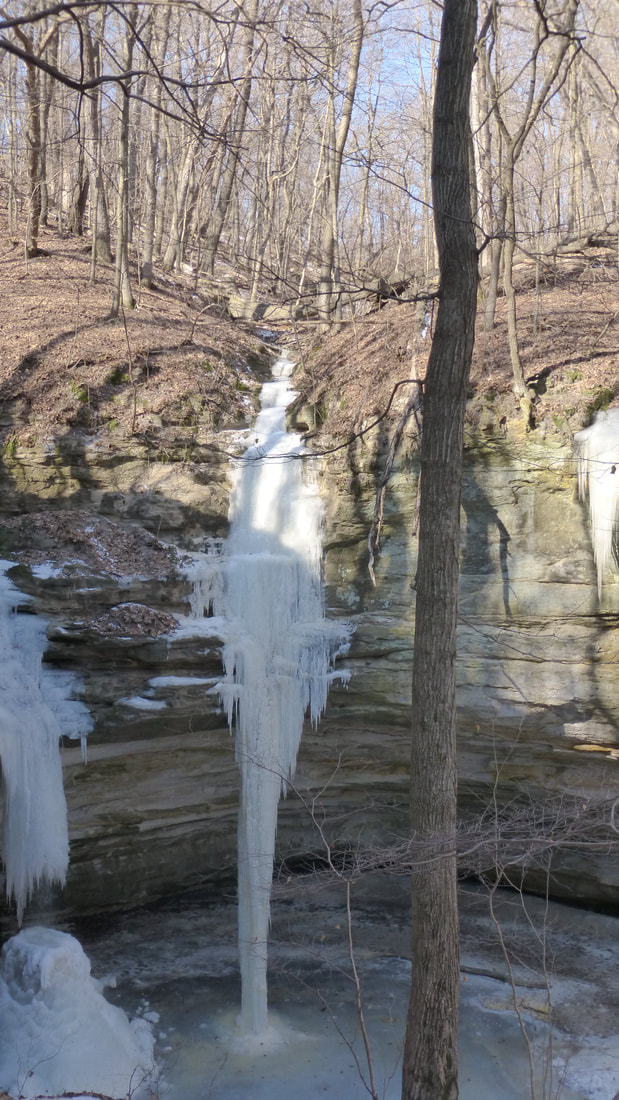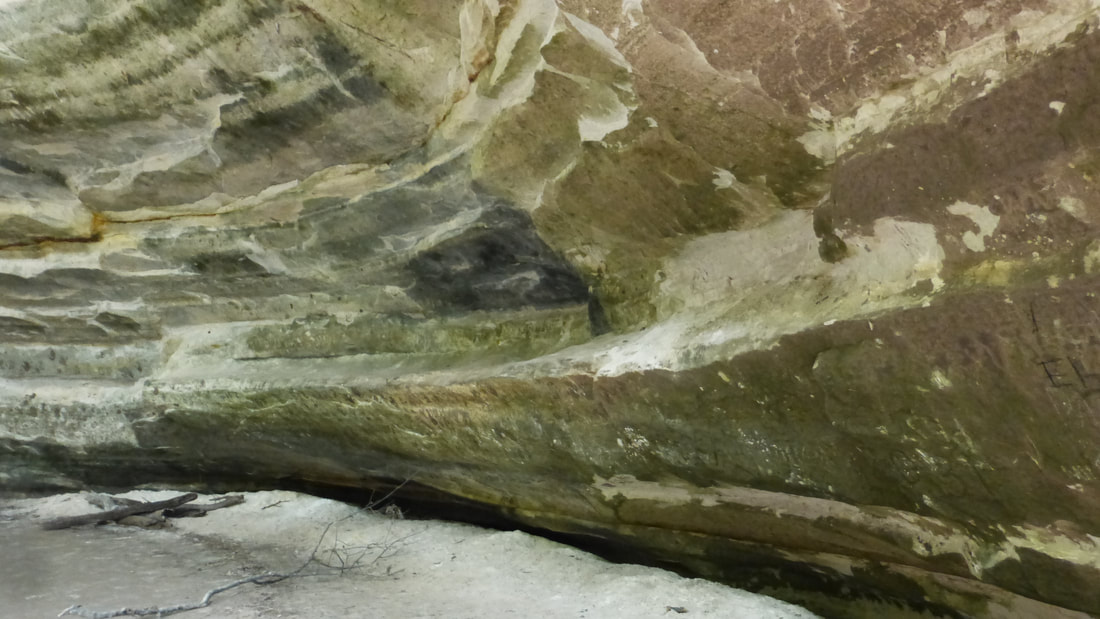A deep canyon interrupts the line of a forested bedrock bluff. The tan sandstone walls are mostly vertical cliffs leading down to a broad, sandy floor partly occupied by a shallow stream. It is an easy, level walk upstream to the head of the canyon, but that place is a dead end where the cliffs join together in a great overhang behind a trickling waterfall. This spot has paired ice falls in winter.
Dimensions This canyon is a quarter mile (400 m) long, its floor is about 100 feet (30 m) wide, and its walls are 50 feet (15 m) high. The near-circular pool below the waterfall is 40 feet (12 m) across and about two feet (0.6 m) deep. A 12 foot (4 m) wide stream, usually several inches (10-20 cm) deep, runs the length of the canyon.
Key Details
- Mature trees grow on much of the canyon floor, though the ground is more clear on flat areas near the canyon head and waterfall. In summer and autumn, undergrowth on the high ground above the cliff tops blocks view of the edge for hikers there, spelling additional danger.
- Similar canyons in this area have high vertical walls on both sides as well as their heads, offering no means of safe entry to or exit from their floors other than a trek back down to the canyon mouths. However one wall of this particular box canyon had a major collapse near the canyon head in the last century, which left a tall pile of sand and sandstone blocks there. The slopes on the tree-covered pile's edges take some effort to climb, with loose sand and fallen leaves sliding underfoot, but its crest almost reaches the top of the canyon wall. An easy climb up or down about ten feet (3 m) of sandstone cliff face is all that is needed there.
- The small stream feeding the waterfall has its heaviest flow in late spring, when water can cover the full width of the flat floor during storms. Water also seeps heavily from indented rock layers on the canyon walls at this time. In spring the waterfall is an energetic cascade, but it diminishes to a thin veil of water in late summer and the fall.
- In winter this canyon has two main ice falls. As seen in the week these photos were taken, the main waterfall spill point has a cluster of icicles suspended above a massive ice mound, a sort of ice stalagmite. The second fall, a barely noticeable trickle of water in the summer, has become a full ice column reaching down to the frozen pool surface. At other times of the winter, both falls will be only icicle chandeliers, or both will be solid ice columns.
- The top of the ice mound beneath the main falls is a water-filled crater two to three feet (up to 1 m) deep, continually showered by frigid water from the icicles above. It has a solid and very level ice rim. The irregular surface lower down on the mound 's slopes includes thick, frozen-in pieces of icicle fallen there earlier.
- Overhang of the wall at the canyon head is quite extreme, so that the waterfall's summer trickle drops to to the canyon floor about 20 feet (6 m) from the wall's base. The shallow pool does not extend all the way to the back of the large alcove behind the falls, and there is space for about 20 people to shelter from rain there with dry feet.
- While the surface of the frozen pool is smooth, knobby mounds of ice surround the base of the ice mound, and climb up its sides. All these surfaces will be especially slippery when temperatures are a bit above freezing and liquid water is continually spattering over them.
- Moisture seeping from the sandstone helps its surface to disintegrate into loose sand grains, which form light-colored piles at the bases of the overhanging walls.
- While most of the canyon floor is sandy, the pool beneath the waterfall contains clay-rich mud that running water in the summer carries down from the forest soils above. This mud can be used to stamp hand prints and other finger-painted marks that stand out on near-white sandstone faces which appear where darker surface rock has recently fractured away. These marks might last a week or two before rain washes them off.
- In late spring, the canyon often has clouds of mosquitoes present. Poison ivy can be encountered in the underbrush.
- Cool air lingers on the canyon floor on summer days, and in spring it allows accumulations of snow and ice to persist against the canyon's southern wall when they are long disappeared elsewhere.
Story Elements
- Many parts of the canyon-side cliffs are quite sheer, impossible to climb without aid of ropes. Possible hand- and toe-holds seen on the cliffs are less reliable than they might appear, with the rock surface slowly disintegrating into loose sand grains.
- There is a recessed notch at the cliff base in some parts of the canyon. A character might crawl into this to hide from others that are above them on the cliff top.
- After summer or fall thunderstorms the waterfall may have enough of a curtain of water to conceal one or two people in the shadows behind it. This could allow their sudden appearance as others arrive for a council or parlay. This recess beneath the overhang also provides room in the winter for several people to hide from view behind the large ice mound.
- Ice falls collapse with great crashing sounds as warmer weather arrives. A character's witness of is kind of occurrence in the canyon might punctuate an internal journey from winter to spring.
- To complete a mid-winter rite of passage, a character might be required to make a difficult climb up the ice mound below the main falls, and bathe or stand in the pool at its top, under icy falling water.
- A hand print stamped in mud on the rock walls, renewed week by week, might mark the territory of a particular group of people or creatures.
- An object lost months ago might be discovered within an the mound as it melts, or noticed at the base of a rock overhang when a toe bumps against something solid within a loose sand pile.
- The stream on the canyon floor continues to flow through the winter, often covered by a sheet of ice. Those walking the length of the canyon will find it difficult to avoid making at least two stream crossings, and so will have the challenge of determining which parts of the mottled ice surface will bear weight. The consequence of a breakthrough is limited: a few inches drop into cold water that will only wet someone's lower legs, and little chance of falling over so long as the person is moving slowly and stays calm. However as part of extended exposure in quite cold weather, this could be felt as quite a set-back. A character running across the ice might also be tripped up by a breakthrough.
- Combat Dynamics:
- Distance fighters on tops of the cliffs might control much of the canyon floor in seasons when trees there are not in full foliage. The position is well protected from any approach from below. However if attack were to come from woods on the upper ground behind them, the distance fighters would be in danger of being pushed off the cliff edge. Snipers trying to hit targets just below at the cliff base or under the overhang at the canyon head might need to lean uncomfortably far out over the cliff edge, possibly with the aid of companions holding their legs or with anchoring harnesses tied to trees.
- Massive icicles hanging from the cliff edges or lip of the falls might be broken or blasted loose to fall on those below.
- Trees on much of the canyon floor can provide partial concealment for stealthy approach, and complicating obstacles in melee confrontations.
- A group suddenly appearing over the cliff edge at top of the sand mound, flooding down its steep slopes to the canyon floor, could have a considerable element of surprise as well as momentum to support a forceful charge. A fighter's descent on the slope could be punctuated by great leaps, slides down sand slopes, and pushes against tree trunks to brake or alter direction of movement.
- The pool below the falls presents movement-slowing terrain in summer, and an area of slip hazard in winter. This focuses approach to and exit from the canyon-head overhang area into about twenty feet (6 m) width corridors next to the rock walls. One of these is on flat sand; the other is fairly steep, part of the lower slope of the huge sand pile on the canyon side.
Reference Location
Ottawa Canyon, Starved Rock State Park, northern Illinois. This location is within a half mile of the Rock Shelter scene described on this website.
© Rice-Snows 2020
Proudly powered by Weebly


















